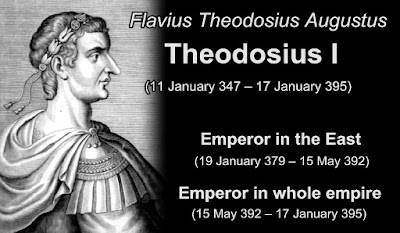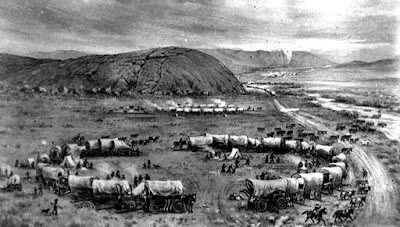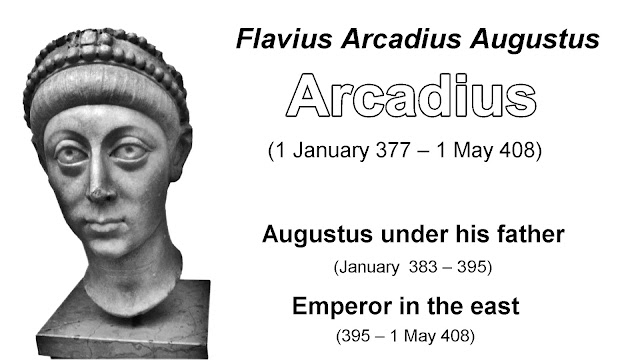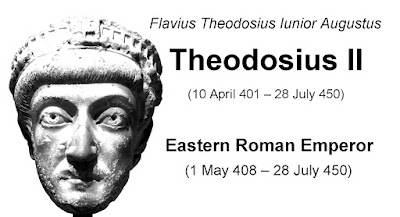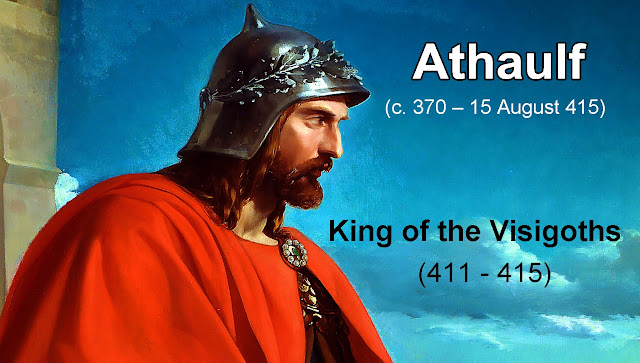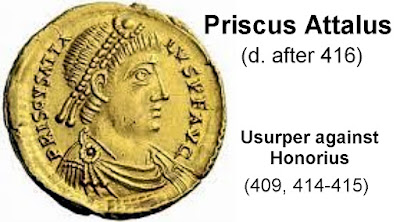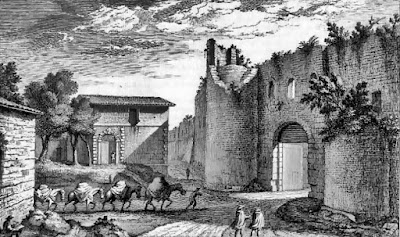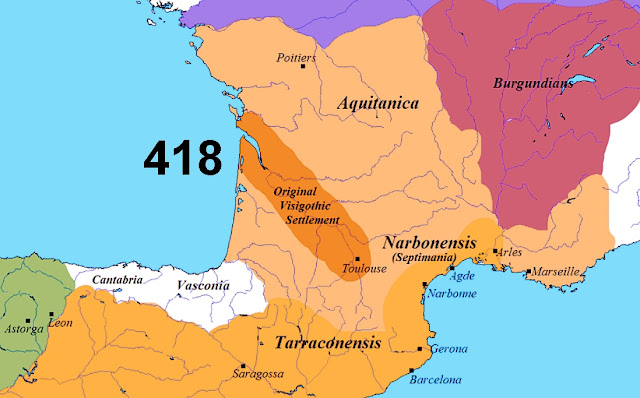Thursday, April 6, 2023
Sack of Rome by Alaric in 410
The Sack of Rome which occurred on August 24, 410, was done by the Visigoths led by King Alaric. At that time, Rome was no longer the capital of the Western Roman Empire, having been replaced in that position first by Mediolanum in 286 and then by Ravenna in 402.
For centuries the people of Rome lived comfortably behind the walls of their city. The empire was continually expanding, and the army, under a long series of capable military commanders, kept the dreaded barbarians safely away from the city’s gates. Unfortunately, the supremacy of Rome began to slowly decay when the empire was split into two by Diocletian, and the power base gradually moved to Constantinople.
The Goths, one of the Germanic tribes, had invaded the Roman Empire on and off since 238. In 376, the Huns forced many Therving Goths to seek refuge in the Eastern Roman Empire. Soon after, starvation, high taxes, hatred from the Roman population, and governmental corruption turned the Goths against the Empire. The Goths rebelled and began looting and pillaging throughout the eastern Balkans. A Roman army, led by the Eastern Roman Emperor Valens, marched
to put them down. At the Battle of Adrianople in 378, Fritigern decisively defeated emperor Valens, who was killed in battle. Peace was eventually established in 382 when the new Eastern Emperor, Theodosius I,
signed a treaty with the Thervings, who would become known as the Visigoths. The treaty made the Visigoths subjects of the empire as foederati. They were allotted the northern part of the dioceses of Dacia and Thrace, and while the land remained under Roman sovereignty and the Visigoths were expected to provide military service, they were considered autonomous.
In 391, a Gothic chieftain named Alaric was declared king by a group of Visigoths, though the exact time this happened and nature of this position are debated. Although labelled as a barbarian, Alaric was a Christian who received his military training in the Roman army. He commanded the Gothic allies, fighting alongside the Romans at the battle of River Frigidus in 394, a battle waged
between the eastern emperor Theodosius I and the western usurper emperor Eugenius. Shortly after the battle, in 395, Emperor Theodosius, the last to unite and rule both halves of the empire, died. The empire was again divided. Alaric’s nemesis, and later ally, the ambitious Flavius Stilicho became regent, or at least claimed to be, for the former emperor’s two sons, Arcadius and Honorius. Arcadius became emperor in the east, while the younger Honorius would eventually assume the throne in the west.
When Theodosius died on January 17, 395, the Visigoths considered their 382 treaty with Rome at an end. Alaric quickly led his warriors back to their lands in Moesia, gathered most of the federated Goths in the Danubian provinces under his leadership, and instantly
rebelled, invading Thrace and approaching the Eastern Roman capital of Constantinople. Magister utriusque militia Stilicho marched east at the head of a combined Western and Eastern Roman army out of Italy. Alaric fortified himself behind a circle of wagons on the plain of Larissa, in Thessaly, where Stilicho besieged him for several months, unwilling to seek battle. Eventually Arcadius, under the apparent influence of those hostile to Stilicho, commanded him to leave Thessaly. Stilicho obeyed the orders of his emperor, sending his Eastern troops to Constantinople, and leading his Western ones back to Italy. The withdrawal of Stilicho freed
Alaric to pillage much of Greece, including Piraeus, Corinth, Argos, and Sparta. Athens was able to pay a ransom to avoid being sacked. Eastern Roman government offer terms to Alaric in 398. They made Alaric magister militum per Illyricum, giving him the Roman command he wanted and giving him free rein to take what resources he needed, including armaments, in his assigned province.
Aurelianus, the new praetorian prefect of the east, stripped Alaric of his title to Illyricum in 400. Between 700 and 7000 Gothic soldiers and their families were slaughtered in a riot at Constantinople on July 12, 400. While Stilicho was busy fighting an invasion of Vandals and Alans in Rhaetia and Noricum, Alaric led his people into an invasion of Italy in 401, reaching it in November without encountering much resistance. The Goths captured a few unnamed cities and besieged the Western Roman capital Mediolanum. Honorius, fearful after the near capture of Mediolanum, moved the Western Roman capital to Ravenna, which was more defensible with its natural swamps and more escapable with its access to the sea.
In time, Alaric became an ally of Stilicho, agreeing to help claim the praetorian prefecture of Illyricum for the Western Empire. To that end, Stilicho named Alaric magister militum of Illyricum in 405. The Roman commander listened to Alaric’s demand of legal rights to their land with annual payments of gold and grain. In return, Alaric was to assist Stilicho in his plan to invade the east. With Arcadius in full power in the east, Stilicho had already secured himself in the west. He had married his daughter to Emperor Honorius, and with the help of Alaric, he would attack the east, dethroning Arcadius.
Eastern Roman Emperor Arcadius died on May 1, 408 of illness. He was succeeded by his young son, Theodosius II. Honorius wanted to go East to secure his nephew’s succession, but Stilicho convinced him to stay and allow Stilicho himself to go instead. Olympius, a palatine official and an enemy of Stilicho’s spread false rumors that Stilicho planned to place his own son Eucherius on the throne of the East, and many came to believe them. Stilicho warned against the emperor leading the army, choosing to lead an army himself. With Stilicho away, Honorius and Olympius traveled to Ticinum, an Italian city just south of Milan, supposedly to review the troops.
However, Olympius, without the permission of the emperor, ordered the killing of thousands of Gothic allies - an action that further angered Alaric. A final fatality of this massacre was Stilicho himself, who was accused of plotting with Alaric. As a result of this treachery, over 10,000 soldiers defected and joined Alaric’s army. In 408 the Gothic army sacked the cities of Aquilea, Concordia, Altinum, Cremona, Bononia, Ariminum, and Picenum, choosing, however, to avoid Ravenna, the capital of the western empire and home of Emperor Honorius. Instead, Alaric set his sights on Rome.
The Goths under Alaric laid siege to the city in late 408. Hopes of help from the Imperial government faded as the siege continued and Alaric took control of the Tiber river, which cut the supplies going into Rome. Grain was rationed to one-half and then one-third of its previous amount. Starvation and disease rapidly spread throughout the city, and rotting bodies were left unburied in the streets. The
Roman Senate then decided to send two envoys to Alaric. Alaric demanded all the gold and silver, household goods, and barbarian slaves in the city. Ultimately, the city was forced to give the Goths 5000 pounds of gold, 30000 pounds of silver, 4000 silken tunics, 3000 hides dyed scarlet, and 3000 pounds of pepper in exchange for lifting the siege. The barbarian slaves fled to Alaric as well, who swelled his ranks to about 40000. Honorius consented to the payment of the ransom, and with it the Visigoths lifted the siege and withdrew to Etruria in December 408.
Honorius remained blind to the seriousness of the situation. While temporarily agreeing to Alaric’s demands - something he never intended to honor – 6000 Roman soldiers were sent to the city but were quickly defeated by Alaric’s brother-in-law Athaulf. Alaric wanted yearly tribute in gold and grain, and lands in the provinces of Dalmatia, Noricum, and Venetia for his people. Honorius sent an insulting letter to Alaric, which was read out in the negotiations.
Realizing further negotiations were impossible, Alaric returned to the gates of Rome in late 409. Faced with the return of starvation and disease, the Senate met with Alaric. He demanded that they appoint one of their own as Emperor to rival Honorius, and he instigated the election of the elderly Priscus Attalus to that end, a pagan who permitted himself to be baptized. Alaric was then made magister utriusque militiae and his brother-in-law Ataulf was given the position comes domesticorum equitum in the new, rival government, and the siege was lifted.
Honorius arranged for a meeting with Alaric about 12 kilometers outside of Ravenna. As Alaric waited at the meeting place, Sarus, who was a sworn enemy of Ataulf and now allied to Honorius, attacked Alaric and his men with a small Roman force. Alaric survived the attack and, outraged at this treachery and frustrated by all the past failures at accommodation, gave up on negotiating with Honorius and headed back to Rome, which he besieged for the third and final time.
On August 24, 410, the Visigoths entered Rome through its Salarian Gate, according to some opened by treachery, according to others by want of food, and pillaged the city for three days.
Because the barbarians had converted to Christian sect Arianism, it was not a particularly violent looting with relatively little rape, murder and damage to buildings. Some famous monuments and buildings were left untouched, and since the Goths were Christians, they allowed people to take refuge inside the basilicas of St. Peter and St. Paul. Many of the city's great buildings were ransacked,
including the mausoleums of Augustus and Hadrian, in which many Roman Emperors of the past were buried. Structural damage to buildings was largely limited to the areas near the old Senate house and the Salarian Gate, where the Gardens of Sallust were burned and never rebuilt. The Basilica Aemilia and the Basilica Julia were also burned.
After three days of looting and pillage, Alaric quickly left Rome and headed for southern Italy. He took with him the wealth of the city and a valuable hostage, Galla Placidia, the sister of emperor Honorius. The Visigoths ravaged Campania, Lucania, and Calabria. Nola and perhaps Capua were sacked, and the Visigoths threatened to invade Sicily and Africa. However, they were unable to cross the Strait of Messina as the ships they had gathered were wrecked by a
storm. Alaric died of illness at Consentia in late 410, mere months after the sack. According to legend, he was buried with his treasure by slaves in the bed of the Busento river. The slaves were then killed to hide its location. The Visigoths elected Ataulf, Alaric's brother-in-law, as their new king. The Visigoths then moved north, heading for Gaul. Ataulf married Galla Placidia in 414, but he died one year later. The Visigoths established the Visigothic kingdom in southwestern Gaul in 418.
This was the first time Rome had been sacked in 800 years, after this was done by Gallic tribes led by Brennus in 390 BC. It was shocking to people across both halves of the Empire who viewed Rome as the eternal city and the symbolic heart of their empire. Tens of thousands of Romans fled the economically ruined city into the countryside, with many of them seeking refuge in Africa. The city of Rome's total population fell from 800,000 in 408 to 500,000 by 419. A more severe sack of Rome by the Vandals followed in 455, and the Western Roman Empire finally collapsed in 476 when the Germanic Odovacer removed the last Western Roman Emperor, Romulus Augustulus, and declared himself King of Italy.





